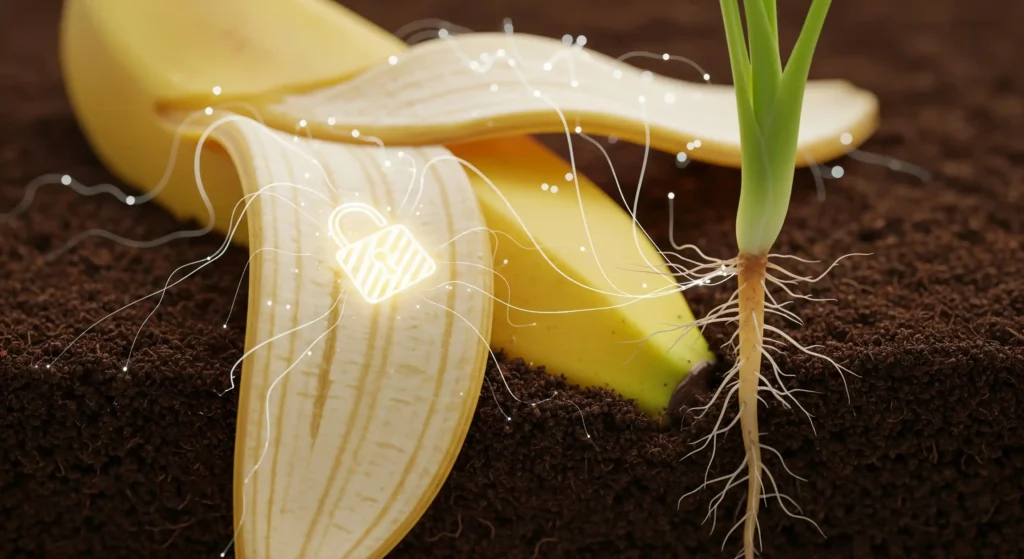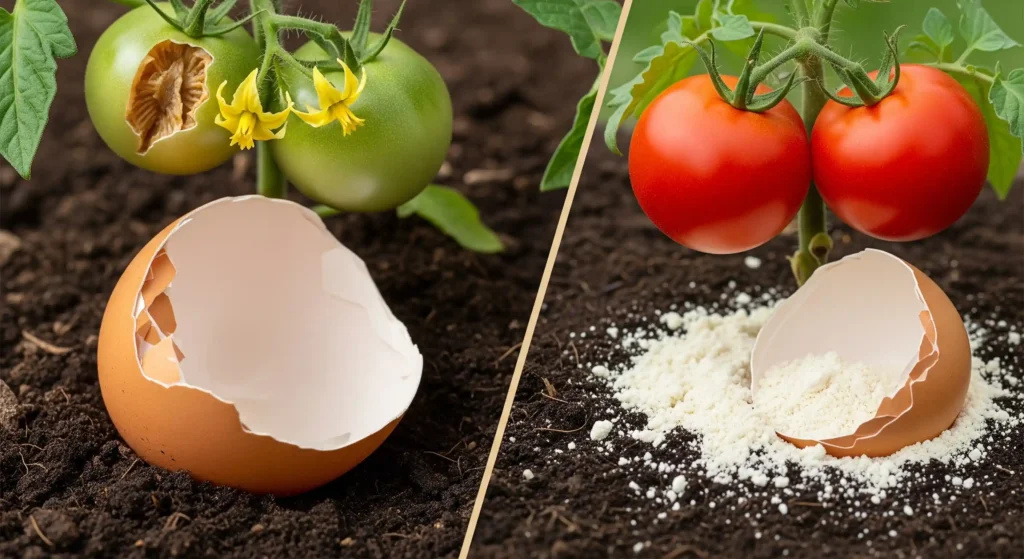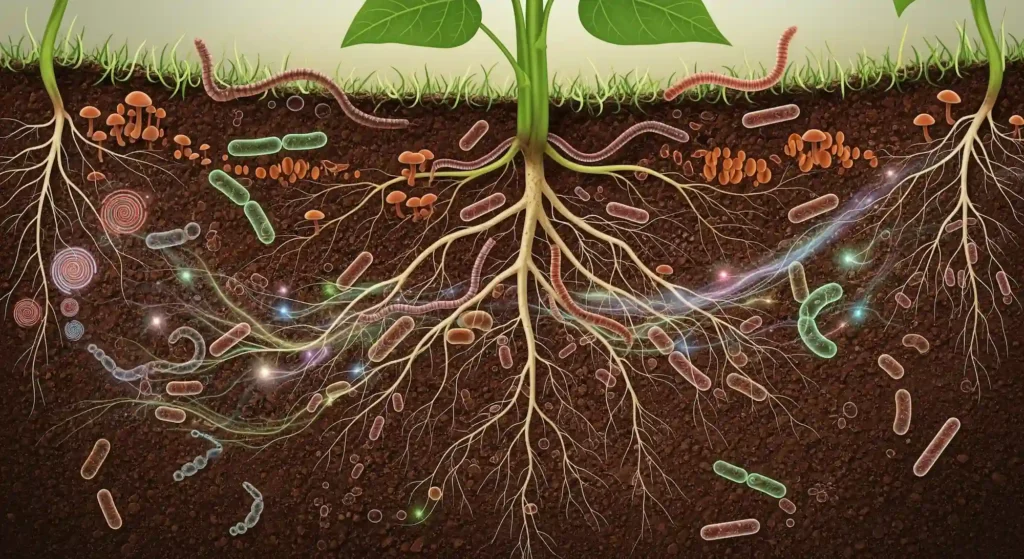The Real Truth About Banana Peels, Coffee Ground, and Eggshells—Your Garden is Being Lied To.
Like me, you have a small bucket on your kitchen counter where you gather the daily food wastes. From your breakfast smoothie, the banana peel, the coffee grounds from your morning brew, the eggshells from your weekend scramble. It makes perfect sense, doesn’t it? It appeals to that great need to be sustainable, cut waste, and feed our gardens something natural. In a world of fast fixes and pharmacological answers, it seems like we are finishing a necessary, healthy cycle and returning the earth that feeds us.
You have seen the picture-perfect Instagram photos and viral videos on TikTok that promise these little pieces to be miraculous fertilizers. From things you were about to toss, the boasts are seductive: more blooms, healthier plants, and a pest-free paradise. But as a gardener who has experimented with almost everything over the years, I’m here to share a small secret with you, one that will spare you a lot of uncertainty and possible disappointment: Although the advantages concealed inside these scraps have some validity, employing banana peels, coffee grinds, and eggshells for plants is not the magic bullet many say it to be. Plants mostly cannot access their raw form, so how you prepare and use them will make all the difference in whether your garden suffers or thrives.
Let us so grab our gardening gloves and spend a day acting as soil detectives. This is your unambiguous, scientifically based manual for discerning fact from fiction. By the conclusion of this, you will know the basic yet intriguing science of soil biology and nutrient availability and be able to boldly turn kitchen trash into a real garden asset.
Just Pest Bait or a Potassium Powerhouse: The Promise of the Banana Peel
Certainly the most well-known of all kitchen garbage ideas, the banana peel is a real superstar of garden mythology. Just drop a peel next to your prize-winning roses or bury one in the planting hole with your tomatoes for a great potassium boost, which will produce more vivid blossoms and better, more plentiful fruit. Sounds ideal, then.

The Myth
The myth is that burying or throwing an entire banana peel on the ground will provide your plants a great, instantaneous supply of potassium for larger, better fruits and blossoms.
The Fact (The Science)
The fact (the science) is quite true: banana peels abound in potassium (K), a macronutrient plants urgently need. From controlling the water pressure within plant cells (turgor pressure), which keeps them from wilting, to activating dozens of vital enzymes and moving glucose to growing fruits, potassium is the great regulator. The trouble is that the strong, fibrous cellulose of the peel locks potassium tightly inside. Your plants cannot immediately benefit from this organic form. Consider it as a treasure chest: the potassium is the gold within the chest; the peel is the chest; the only people with the key are the microorganisms in your soil.
Your tomato plant needs a large, invisible army of helpful soil bacteria and fungi first go through a process known as mineralization if it is to derive any benefit. That stiff organic stuff must be physically broken down and gradually released the potassium into the soil as a simple, inorganic ion (K+) that plant roots can really absorb through water. Weeks pass during this process; more commonly, months pass.
Using full, raw peels in your garden runs more risks than it benefits. Fruit flies and fungus gnats find great attraction in the sugars found in the rotting peel. In many places, they constitute an open invitation for bigger nighttime visitors including raccoons, possums, and rodents to rummage among your expensive petunias. Often becoming a slimy, moldy mess that might introduce undesired pathogens or produce anaerobic (oxygen-lacking) area that suffocates the soil beneath it, the peel decays on the surface. Moreover, a crumbling peel might momentarily form a water-repellent (hydrophobic) barrier on the ground, therefore stopping water from getting to the roots underneath.
The Right Way
By supporting the breakdown process, you can actually influence things.
- The Gold Standard is composting; this is absolutely the greatest approach. Cutting your banana peels—the smaller the pieces, the faster they will break down—then adding them to a well-managed compost pile lets them break down in a regulated, hot, and effective environment that also kills off possible viruses. Mixed with a variety of other organic components, those nutrients—once composted—are totally mineralized and ready for your plants to consume right away.
- “Banana Peel Tea”: Over a few days, soak some peels in a jar of water. This will infuse into the water a tiny concentration of potassium and other trace minerals soluble in water. Just note that this is a somewhat light, brief liquid feed. Consider it more as your plants’ vitamin water than as a complete, balanced dinner. It’s a complement rather than a replacement for appropriate fertilizer since it lacks the necessary nitrogen and phosphorous for total plant health.
- If you have a dehydrator or are ready to use your oven on lowest setting, you can dry the peels until they are brittle and then crush them fine in a blender or coffee grinder. Once you put it into your potting soil or top-dress it around the base of a plant, this greatly increases the surface area available to soil bacteria, enabling them to break it down far more rapidly. Consider this as building a quite mild, slow-release potassium source and soil conditioner.
Coffee Ground: Overhyped Hype or Dream for an Acid-Lover?
This one is everywhere: use coffee grounds to make your soil more acidic for blueberries, azaleas, and hydrangeas! It’s also sometimes hailed as a miracle slug deterrent and a fantastic supplier of nitrogen. Pour a fresh cup of reality and look at the grounds.

The Myth
The myth is that adding old coffee grounds to the garden increases the acidity of the soil, provides a fantastic supply of nitrogen, and will deter slugs.
The Fact (The Science)
This is a myth with several layers worth examining.
Fresh, unbrewed coffee grounds are in fact acidic. But the brewing procedure is rather good in extracting that acid from your morning cup. Usually falling between 6.5 and 6.8, used coffee grinds have a pH that is rather near to neutral. Though most soils have a natural “buffering capacity,” a resistance to pH, much like a thermostat resists temperature fluctuations in your house, most soils are only mildly acidic. To significantly reduce the acidity of your garden soil in any long-term manner, it would take actual buckets of spent coffee grounds.
Coffee grounds have almost two percent nitrogen by volume, which sounds fantastic on paper. But in organic molecules nitrogen is “locked up”. Here, the Carbon-to–Nitrogen (C:N) ratio is absolutely vital. Coffee grinds have a C:N ratio roughly of 20:1. Consider it this: microorganisms are like building workers. Their building material is carbon, the bricks; their energy source is nitrogen, the mortar and the lunches for the workers. They require a lot of nitrogen fuel if they are to break down all those carbon bricks. The microorganisms start working when you bury a load of coffee grounds into the earth, but they soon discover they lack nitrogen necessary to complete the task. They thereby “steal” the nitrogen that is readily accessible from the surrounding soil, so producing a temporary nitrogen deficit—a process known as “nitrogen immobilization.” For young seedlings especially, this can be rather difficult and result in yellowing leaves and slowed development.
Pest Control: A classic garden myth holds that a scratchy ring of coffee grounds would discourage soft-bodied slugs and snails. Scientific research has sadly proved it to be absolutely useless. Though probably somewhat more energized, slugs will gladly glide right over them, undeterred.
The Right Way
Start seeing coffee grinds as a great soil supplement or compost component instead of a fertilizer. Their actual worth rests in their bodily form. Their fine texture does miracles for soil tilth whether fully composted (where the nitrogen immobilization occurs securely inside the pile) or mixed well into the first few inches of your garden beds. Through a process known as aggregation, they enable little clay particles to cluster together, so improving the structure for air, water, and root movement through. They increase water retention in sandy soils by functioning as little sponges. As they completely break down, they are a wonderful source of organic matter that will gently and over time release their nutrients.
Unscrambling the Truth: Do Eggshells Provide Your Garden With Enough Calcium?
The eggshell, ah. To give a blast of calcium and stop the terrible blossom end rot, we are advised to crush them and toss them into our tomato planting holes. This may be the most misinterpreted trick of them all, producing a lot of well-meaning but useless gardening.

The Myth
Tossing crushed eggshells in your planting hole can supply quick calcium to stop blossom end rot in tomatoes and peppers.
The Fact (The Science)
About 95% of eggshells are calcium carbonate, the exact same rock-stable chemical found in limestone and chalk. It breaks down extremely, very slowly and is quite strong. Most garden soils can take many months, or more commonly years, for that calcium to become accessible to plants. Moreover, blossom end rot is practically always a physiological condition connected to uneven watering, not a shortage of calcium in the soil. Like the rebar in concrete, calcium is an essential mineral that gives plant cell walls their strength and framework. But it only moves via the xylem, or vascular system, of the plant using water. Should the water supply be erratic—think of a drought followed by a flood—the plant cannot sustain the consistent flow required to move calcium to its most far-off, recent development, the blossom end of the fruit. The end effect is a deep, dark area even in a soil with lots of calcium. Not a “calcium supply” issue, it’s a “calcium absorption” one.
The Right Way
You have to drastically increase the surface area of eggshells to give bacteria something to work with if they are to offer any benefit in a sensible period of time.
First rinse the shells to eliminate any protein membrane—which can draw germs—then let them totally dry. A low oven for a few minutes will help you speed this up. Next ground them into a powder as fine as flour using a vigorous blender or coffee grinder. This lets soil bacteria get right to work on them far more effectively. Though then, consider it as a very slow-release, long-term soil additive that will gently buffer soil pH over years, not a rapid remedy for nutrient shortages.
Making a calcium-acetate solution will provide a quicker (albeit more labor-intensive) approach. Gradually add simple white vinegar to a container containing your finely ground eggshell powder. It will fizz and bubble. The chemical process Calcium Carbonate + Acetic Acid → Calcium Acetate + Water + Carbon Dioxide transforms the rock-stable carbonate into a water-soluble acetate form. The calcium is then accessible when the fizzing ceases. Before applying this solution—at least one tablespoon per gallon of water—as a soil drench for your plants, you must greatly dilute it since the solution itself is acidic and can damage roots if used concentrated.
Ultimately, from Garden Gold to Kitchen Scraps

What then have we gained knowledge of? There is definitely great potential trapped within our kitchen trash. Raw potential, though, differs from plant-available nutrition. One vital, sometimes disregarded biological process drives the path from a banana peel, a scoop of coffee grounds, or an eggshell to a nutrient your plants can really use: breakdown.
And composting is obviously the best, safest, and most efficient method available for controlling that process. A good compost pile is a regulated ecosystem rather than a garbage container. Here you balance nitrogen “greens” and carbon “browns,” preserve moisture, and create a vibrant, varied population of microorganisms that turns your trash into dark, crumbly, nutrient-rich soil conditioner, or humus, so enhancing both fertility and structure. The real magic bullet for your lawn is this “black gold.”
So the next time you come across a viral gardening technique, you’ll be ready to ask, “But what’s the science behind it?” The true truth about using banana peels, coffee grounds, and eggshells for plants is a satisfying “it depends”—and now you’re one of the smart gardeners who knows exactly what it depends on. Simple “yes” or “no” isn’t the answer.
Often Ask Questions
Can I just toss a banana peel right next to my rose bush?
That is not advised. Although it will finally break down, the process can draw rodents and bugs. More crucially, given its high carbon-to—nitrogen ratio, the first phases of breakdown can “rob” nitrogen from the soil immediately adjacent to your rose’s roots, so perhaps impeding its growth before it finally releases nutrients months later. Starting with composting is a far safer and more efficient method.
Will burning my plants with plenty of coffee grinds ruin them?
Though spreading a thick, unmixed layer on the surface is a terrible idea, it’s doubtful they will “burn” them in a chemical sense. It can create a thick, water-repellent coating that keeps air and moisture out of reaching the roots. To avoid this compaction problem, always mix them into your soil or, better still, your compost heap.
How perfect do my eggshells really have to be?
Think not of bits but of powder. The better the finer it is. Imagine dissolving in water a sugar cube instead of a tablespoon of powdered sugar. Given its great surface area, the powder melts practically immediately. Likewise, soil bacteria may break down powdered eggshells far, far faster than roughly broken bits, which might linger in your soil for years with very little effect.
What about other wastes like onion skins or citrus peels?
For the compost heap, they are rather good! Citrus peels are quite nutritious, but use them in moderation as they can be rather acidic. Additionally adding trace nutrients are onion and garlic peels. Diversity and decay are the secret, as with everything else. Composting treats all of them lovingly.
Scientific Sources
This article’s insights are grounded in research and information from the following scientific and authoritative sources:
General Soil Biology & Nutrient Availability
- New Mexico State University Extension. “Soil Biological Processes.” New Mexico State University Extension Publications. Available at: https://pubs.nmsu.edu/_a/A153/index.html
- Oregon State University Extension Service. “Baseline Soil Nitrogen Mineralization: Measurement and Interpretation.” (EM 9281). Oregon State University Extension Service. Available at: https://extension.oregonstate.edu/sites/extd8/files/documents/em9281.pdf
- Rastogi, A., Kumar, A., Kumari, R., & Singh, A. (2023). Soil Microorganisms: Their Role in Enhancing Crop Nutrition and Health. Microorganisms, 11(12), 734. MDPI. Available at: https://www.mdpi.com/1424-2818/16/12/734
Banana Peels
- Scribd. “Banana Peel As An Alternative To Chemical Fertilizer.” Scribd. Available at: https://www.scribd.com/document/505836249/436898791-Banana-Peel-as-an-Alternative-to-Chemical-Fertilizer
- Waziri, M. A., Abdulmalik, Z., Bako, Z. M., Jega, R. M., & Kareem, W. (2024). ORGANIC FERTILIZER PRODUCTION USING BANANA PEEL, EGGSHELLS, AND YEAST: EFFECTS ON AMARANTHUS GROWTH. FUDMA Journal of Sciences, 8(6), 3022. Available at: https://fjs.fudutsinma.edu.ng/index.php/fjs/article/view/3022
Coffee Grounds
- Cornell University. “Compost Chemistry.” CORNELL Composting. Available at: https://compost.css.cornell.edu/chemistry.html
- Ghazaryan, L. (2024). The Science Behind Eggshell Fertilizer. Dirty Fingers Blog. Available at: https://dirtyfingersblog.wordpress.com/2024/03/21/the-science-behind-eggshell-fertilizer/
- Schmidt, J. (2024). Are Coffee Grounds Good for Plants: Uncovering the Truth. Aerial Resupply Coffee Blog. Available at: https://aerialresupplycoffee.com/blogs/the-resupply-blog/exploring-the-benefits-of-coffee-grounds-for-plants
- University of Minnesota Extension. “Coffee grounds, eggshells and Epsom salts in the home garden.” UMN Extension. Available at: https://extension.umn.edu/manage-soil-nutrients/coffee-grounds-eggshells-epsom-salts
- White, T. T., Clay, S., & Gamo, E. (2024). Carbon to Nitrogen Ratio of Healthy Soils. SDSU Extension – South Dakota State University. Available at: https://extension.sdstate.edu/carbon-nitrogen-ratio-healthy-soils
Eggshells
- Ghazaryan, L. (2024). The Science Behind Eggshell Fertilizer. Dirty Fingers Blog. Available at: https://dirtyfingersblog.wordpress.com/2024/03/21/the-science-behind-eggshell-fertilizer/
- HortiJournal. (n.d.). Eggshells as fertilizer in horticulture practices. HortiJournal. Available at: https://www.hortijournal.com/article/view/277/7-3-8
- Mofidi, J. (2016). What is the effect of Calcium Carbonate on soil structure? ResearchGate. Available at: https://www.researchgate.net/post/What-is-the-effect-of-Calcium-Carbonate-on-soil-structure
Blossom End Rot (BER)
- Adams, P., & Ho, L. C. (1992). A Cellular Hypothesis for the Induction of Blossom-End Rot in Tomato Fruit. Planta, 186(1), 1–9. PMC. Available at: https://pmc.ncbi.nlm.nih.gov/articles/PMC4246855/
- Ogbuchiekwe, I., & Ruter, J. M. (n.d.). Blossom-End Rot and Calcium Nutrition of Pepper and Tomato. University of Georgia Extension. Available at: https://extension.uga.edu/publications/detail.html?number=C938&title=blossom-end-rot-and-calcium-nutrition-of-pepper-and-tomato
- UMass Amherst Extension. (n.d.). Solanaceous, Blossom End Rot. UMass Amherst Center for Agriculture, Food, and the Environment. Available at: https://www.umass.edu/agriculture-food-environment/vegetable/fact-sheets/solanaceous-blossom-end-rot
Composting
- U.S. Environmental Protection Agency. (n.d.). Benefits of Using Compost. US EPA Sustainable Management of Food. Available at: https://www.epa.gov/sustainable-management-food/benefits-using-compost
- U.S. Environmental Protection Agency. (n.d.). Composting At Home. US EPA Recycling. Available at: https://www.epa.gov/recycle/composting-home









